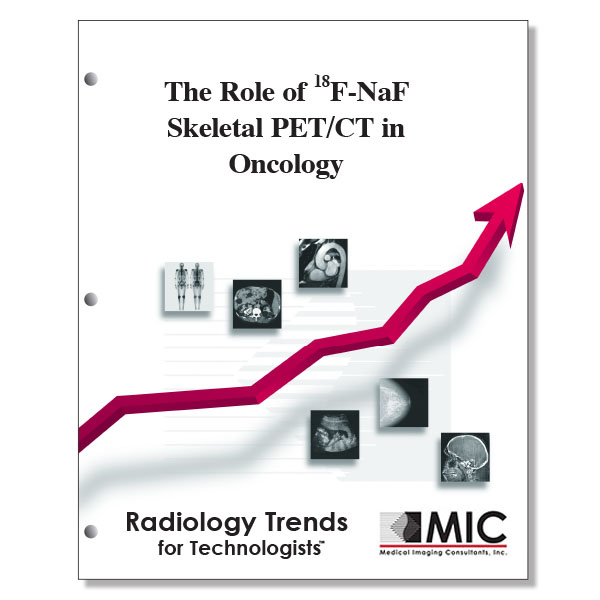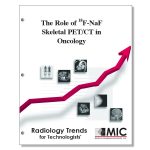

The Role of 18F-NaF Skeletal PET/CT in Oncology
A review of the indications, imaging appearances, and utility of 18F-NaF PET/CT in the evaluation of skeletal disease.
Course ID: Q00420 Category: Radiology Trends for Technologists Modalities: CT, Nuclear Medicine, PET, Radiation Therapy3.0 |
Satisfaction Guarantee |
$34.00
- Targeted CE
- Outline
- Objectives
Targeted CE per ARRT’s Discipline, Category, and Subcategory classification for enrollments starting after February 24, 2023:
[Note: Discipline-specific Targeted CE credits may be less than the total Category A credits approved for this course.]
Computed Tomography: 0.50
Procedures: 0.50
Head, Spine, and Musculoskeletal: 0.50
Nuclear Medicine Technology: 3.00
Procedures: 3.00
Radionuclides and Radiopharmaceuticals: 0.50
Endocrine and Oncology Procedures: 0.50
Other Imaging Procedures: 2.00
Outline
- Introduction
- Sodium Fluoride 18F
- Pharmacokinetics and Biologic Properties
- Comparison of 18F-NaF and 99mTc-MDP as Bone Agents
- Clinical Indications
- 18F-NaF PET/CT Protocol
- Radiation Dosimetry
- Image Interpretation
- Extraosseous Uptake of 18F-NaF
- Limitations
- Comparison of 18F-NaF PET/CT and FDG PET/CT: Which Examination Should Be Performed
- Conclusions
Objectives
Upon completion of this course, students will:
- know the primary tumor types which are most likely to metastasize to bone
- be familiar with the complications of bone metastases
- know the particles actually used for imaging with 18F-NaF
- identify the device which produces nearly all of the clinically used 18F-NaF
- identify the basis of the mechanism of skeletal uptake of 18F-NaF
- know how 18F-NaF uptake indicates osteoblastic activity
- understand the comparative advantages of 18F-NaF over 99mTc-MDP
- understand why 18F-NaF patients can be imaged 1 hour or less post injection
- know the advantages of bone imaging with 99mTc-MDP over 18F-NaF
- identify imaging modalities that improve 99mTc-MDP bone imaging specificity
- know a key similarity between 99mTc-MDP and 18F-NaF bone imaging
- understand why 18F-NaF depicts spinal lesions before 99mTc-MDP imaging
- identify the area of the body where the superior spatial resolution of 18F-NaF is particularly important
- identify the current primary usage for 18F-NaF PET/CT
- identify the initial imaging modality of choice for the evaluation of suspected child abuse
- know the imaging modality of choice for evaluating the viability of the remaining femoral head after surgery
- know the metabolic bone diseases that can be evaluated with 18F-NaF functional imaging
- understand how 18F-NaF imaging can benefit in the characterization of the biology of atherosclerotic plaques
- be familiar with the recommended dosages of 18F-NaF
- know the factors that affect the time of imaging per bed position for 18F-NaF
- understand the value of attenuation correction for 18F-NaF imaging
- be familiar with the reasons for encouraging hydration for 18F-NaF imaging
- understand the factors which effect radiation dosimetry in 18F-NaF PET/CT
- identify the organ/structure which receives the highest radiation dose in 18F-NaF PET imaging
- know the normal uptake pattern of 18F-NaF within the body
- understand the mechanism by which metastatic lesions are visualized in 18F-NaF bone imaging
- be familiar with what the discovery of bone metastases from breast cancer may indicate for a patient
- know instances where 18F-NaF can better depict lesions than FDG PET/CT
- be familiar with benign processes demonstrating increased 18F-NaF uptake
- understand SUV limitations in 18F-NaF imaging interpretation
- understand possible implications of 18F-NaF uptake in atherosclerotic plaque
- know the possible interpretation of spinal lesions not associated with the endplate or joint surface that do not show a typical 18F-NaF uptake pattern
- know the differences in 18F-NaF and FDG purpose and uptake pattern
- know sites for which FDG PET imaging is advantageous
- be familiar with the differences in 18F-NaF and FDG prospective evaluations
